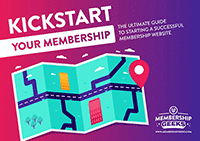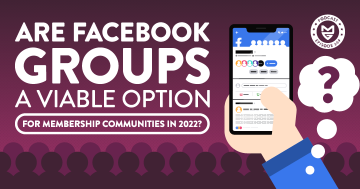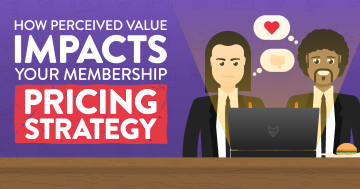Whether you're teaching a specialist subject, or want to support others who share your interests, it's now easier than ever to reach a global audience and get paid for sharing your time, skills, experience and expertise.
Two of the best models for doing so are online courses and paid membership sites.
However with those terms often used loosely and interchangeably, it can be tricky figuring out which is best for you.
As such you may find yourself asking: “What’s the difference between an online course and a membership site?’
Or, more specifically: ‘”Which should I create?”
The truth is, online courses and membership sites share many similarities and overlaps, which only muddies the matter further.
So what are the actual differences?
What is a Membership Site?
A typical membership site includes:
- Access tied to payment (i.e. monthly fee)
- Release of regular new content
- Access to an ongoing community
- No set endpoint (membership continues indefinitely)
The content in a membership site may take a variety of different forms, including courses, and typically cover open ended topics that can be expanded upon over time.
For example, in the Membership Academy, we include a variety of different content types and there is enough information around the topic that we could be creating new courses and content for years!
Membership sites will also typically be open all year round so that you can join anytime and progress at your own pace, although there is an increasing trend in ‘open/close’ membership sites.
Pros and Cons of Memberships vs Courses:
Pros
- There's less expectation for your membership to be a ‘finished’ product. By nature, they are ever evolving, and as such, easier to change and improve over time.
- Memberships deliver recurring revenue – you're not just getting paid once for your work. And while this does mean that you have to think about churn etc, the upside of recurring subscriptions is worth it.
- Generally, memberships will be sold at a lower price point, making them more accessible to a greater percentage of your audience. Over time, members often end up paying the same as they would for a high-priced course, but that cost is broken down and your user is more in control of how they pay.
- While courses are almost entirely centered around content, that's not necessarily the case for memberships. In fact, often it's the community aspect of a membership that delivers the true value.
Cons
- Memberships are a much bigger commitment than creating a course. They're a long term business model. You can’t sign up members and then decide 6 months in that you’re just not feeling it. It's harder to shelve this idea than it is to shelve a failed course.
- It can take longer to reach your financial goals when selling a membership than selling a higher priced course. Courses typically deliver a large cash injection upfront that usually isn't achievable with a membership.
- You need to ensure you're attracting a continuous stream of new members. Of course, courses need continuous purchases too, but the higher price-point means they can be more intermittent with less risk.
- There's often more tech involved in setting up and running a membership website.
What is an Online Course?
A typical online course includes:
- One time fee or instalments granting long term/life time access to content
- Module & lesson content structure
- Defined content path or A-Z steps
- Content drip fed or available all at once
- Progress tracking, quizzes, or assignments
- Group or 1-2-1 support
Online courses will often have a fixed start date so that a group of people work through your course content together. However, self study courses and Evergreen courses are also popular.
The content of a course usually has a clearly defined start and end point, unlike in a membership. For example, a course on Facebook Ads would take you step by step through the Facebook ad process, from start to finish, with the end result being the creation of your own campaign.
Both online courses and membership sites are based around paying for access to exclusive content – the main difference between the two models is the nature of the content itself, and how access to that content is controlled.
A course is typically finite (for example 8 weeks or 6 modules) whilst a membership site is ongoing.
With a membership site you will also typically lose access to the content once your payments stop, however with a course you are typically granted long term access to the content after your payment.
A membership site also provides regular recurring income, whilst a course may be more sporadic depending on the model that you use.
There is plenty of crossover between courses and membership sites though and both will typically use a membership plugin in order to protect content and provide access, hence why a course is typically also referred to as a membership. (For more on the differences between course and membership plugins read ‘Should You Use a Course or Membership Plugin’.)
Pros and Cons of Courses vs Memberships:
Pros
- Courses are generally more clearly defined products in terms of what exactly someone is paying for, what the specific outcomes are etc. In general, this makes them easier for you to market and sell than memberships, which are often a more abstract “big box of stuff”
- It's generally easier to create and sell multiple standalone courses. With memberships, there is often the expectation that all of your content should be included.
- Courses usually sell for a higher one-off fee, meaning a larger immediate cash injection from launches.
- As there's no recurring element, you don’t need to worry about customer retention.
- Once your course is created, your work is essentially done – there's no further work involved in supporting the product.
Cons
- There's a lot more pressure to get everything right with your course. People are buying a finished product, so it needs to deliver at a high value from day one.
- There is a lot of upfront work involved in creating your course before you can sell it. This means there's more risk; if things don't go to plan, that time and effort is wasted.
- A lot rests on the launch, and a bad launch can set you back significantly.
- Harder to expand on the topic of your course and provide supporting material in a manageable way, outside of creating more courses.
Deciding which to create
Often, it will be obvious whether you are creating an online course or a membership site, but if you’re not sure which option is best for you ask yourself the following questions:
Does your chosen topic have a set A-Z path that leads to a defined result?
If you’re teaching a very specific topic that can be broken down into a set number of steps, especially if it’s one that people are likely to want to learn quickly, then a course may be the best option.
Does the topic have enough to it that you could create continuous ongoing content?
A good rule of thumb here is to write a list of all the possible subjects that you could cover. Is there enough to release one piece of content per month for at least a year?
Can you commit to an ongoing site?
A membership site is much more of an ongoing commitment than a course and it’s good to be aware of that from the start and make sure that it fits with your future plans.
A course can be created and sold with very little ongoing work involved, depending on the course model you choose.
Do you want to run an online community?
A community is much more important to the success of a membership site than to a short course.
While it’s still a good idea to have some element of community in a course, whether this is live calls or a Facebook group, courses can also be completed independently.
A membership site, on the other hand, will typically require a strong community element for increased retention, and this takes time and energy to create and moderate.
At the end of the day, there isn’t really a right or wrong answer when it comes to whether it’s better for you to create an online course or a membership site.
What’s important is that you choose the best approach for your topic, your audience and you.
Thank You For Listening
We really appreciate you chosing to listen to us and for supporting the podcast. If you enjoyed today's show, please share it using the social media buttons on this page.
We would also be eternally grateful if you would consider taking a minute or two to leave an honest review and rating for the show in iTunes. They're extremely helpful when it comes to reaching our audience and we read each and every one personally!
Finally, don't forget to subscribe to the podcast in iTunes to make sure that you never miss an episode





